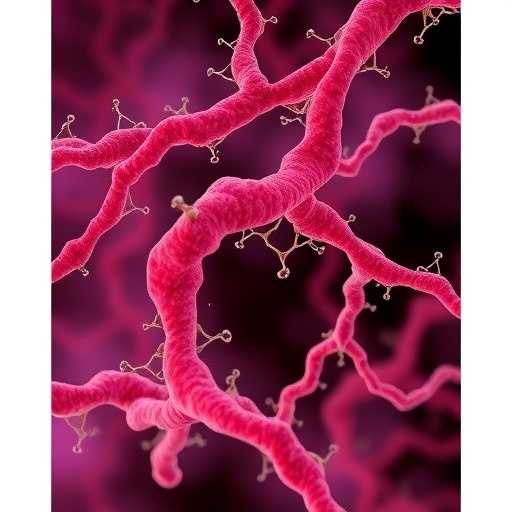
In a groundbreaking advancement that offers new insights into the molecular origins of devastating neurodegenerative diseases, researchers have unveiled the structural underpinnings of amyloid fibrils formed by the proteins CHCHD10 and CHCHD2. These discoveries not only shed light on the intricate mechanisms by which these proteins contribute to neurodegeneration but also open promising avenues for therapeutic interventions targeting conditions such as amyotrophic lateral sclerosis (ALS) and frontotemporal dementia (FTD).
Amyloid fibrils, long known for their association with a variety of neurodegenerative disorders, represent highly ordered protein aggregates characterized by a hallmark cross-β sheet architecture. Despite extensive study, the precise role and structural variations of amyloid fibrils derived from distinct proteins remain incompletely understood. The current study addresses this gap by focusing on CHCHD10 and CHCHD2, two mitochondrial proteins whose mutations have been genetically linked to neurodegenerative pathologies but whose structural behavior in the aggregation landscape had yet to be elucidated.
Mitochondrial dysfunction is a well-established hallmark of neurodegeneration, and CHCHD proteins are integral components of the mitochondrial intermembrane space, involved in crucial regulatory roles related to mitochondrial cristae organization and cellular respiration. Previous genetic studies identified mutations in CHCHD10 and CHCHD2 as contributors to ALS and FTD-like syndromes, yet establishing a direct connection between the aggregated fibrillar forms of these proteins and disease pathology had remained elusive until now.
.adsslot_uYQGRKM6on{width:728px !important;height:90px !important;}
@media(max-width:1199px){ .adsslot_uYQGRKM6on{width:468px !important;height:60px !important;}
}
@media(max-width:767px){ .adsslot_uYQGRKM6on{width:320px !important;height:50px !important;}
}
ADVERTISEMENT
Utilizing high-resolution cryo-electron microscopy (cryo-EM), the investigators meticulously resolved the amyloid fibril structures formed by mutant CHCHD10 and CHCHD2 proteins isolated from patient-derived tissues. These fibrils possess unique polymorphic forms that distinguish them from canonical amyloid fibrils formed by other neurodegeneration-associated proteins such as tau or α-synuclein. The elucidation of these structures at near-atomic resolution reveals subtle yet critical variations in β-sheet stacking, fibril morphology, and interprotofilament interactions that likely underlie their distinct pathogenic profiles.
The research emphasizes the pathological significance of two notable mutations prevalent in familial cases—S59L in CHCHD10 and T61I in CHCHD2—demonstrating how these single amino acid substitutions alter protein folding landscapes to favor fibril formation. Structural analyses indicate that these mutations destabilize the native conformation of the proteins, reduce mitochondrial import efficiency, and promote aberrant aggregation in the cytosol, thereby precipitating cellular stress responses and eventual neuronal death.
Moreover, the study delineates a potential molecular pathway connecting mitochondrial dysfunction to proteostasis failure mediated by these amyloid aggregates. The fibrils disrupt mitochondrial membrane potential and interfere with the electron transport chain, contributing to increased reactive oxygen species (ROS) production and bioenergetic insufficiency. Concurrently, the extracellular release of fibrillar species may propagate neurotoxicity via a prion-like spread, exacerbating disease progression and neuronal network disintegration.
Beyond structural characterization, the research team employed a battery of biochemical assays and cellular models to probe the aggregation kinetics and cytotoxicity profiles of CHCHD10 and CHCHD2 fibrils. Remarkably, seeding experiments revealed that these fibrils could induce recruitment and misfolding of endogenous protein counterparts, underscoring a self-templating mechanism reminiscent of other amyloid disorders. Cell viability assays further demonstrated that fibril exposure led to caspase activation and apoptotic markers, thereby directly implicating these aggregates in neuronal demise.
Importantly, this study also attempts to bridge the gap between genotype and phenotype by mapping the distinct structural conformers to specific clinical manifestations observed in patients. Variations in fibril architecture correspond with differences in disease onset, progression rate, and regional brain vulnerability, hinting at a structural basis for clinical heterogeneity in CHCHD10/CHCHD2-related neurodegeneration. This nuanced understanding could facilitate precision medicine approaches tailored to individual mutation profiles.
From a therapeutic perspective, the identification of discrete amyloid folds associated with pathogenic CHCHD proteins presents a compelling target for the development of conformation-specific antibodies or small molecules designed to inhibit fibril assembly or promote disaggregation. Furthermore, the possibility of mitigating mitochondrial dysfunction via interventions aimed at restoring normal protein import and folding dynamics offers a complementary strategy to confront the multifaceted nature of these diseases.
The revelation of these novel amyloid structures also challenges prevailing paradigms that largely center on cytoplasmic or extracellular aggregates, inviting renewed consideration of mitochondrial amyloidogenesis as an intrinsic driver of neurodegeneration. Such insights underscore the profound complexity of protein homeostasis within electrically active neurons and highlight the vulnerability of mitochondrial systems to protein misfolding pathology.
This breakthrough study exemplifies the power of integrating cutting-edge structural biology techniques with rigorous biochemical and cellular analyses to unravel the elusive relationships between genetic mutations, protein misfolding, and neuronal damage. The deepened molecular understanding garnered here sets the stage for future research exploring the intersection of mitochondrial biology and protein aggregation disorders.
Ultimately, the work not only enriches the foundational knowledge of neurodegenerative disease mechanisms but also represents a beacon of hope for the millions afflicted worldwide. Through continued interrogation of amyloid fibril structures and their pathological sequelae, the scientific community moves closer to novel therapeutic breakthroughs capable of halting or reversing the inexorable progression of ALS, FTD, and related disorders.
In conclusion, the exquisite structural characterization of CHCHD10 and CHCHD2 amyloid fibrils bridges a critical gap between genetic mutations and cellular dysfunction in neurodegeneration. By delineating the architecture and pathogenic mechanisms of these mitochondrial amyloid species, this research transforms our understanding of disease etiology and unlocks promising pathways for innovative therapeutic development in debilitating neurodegenerative diseases.
Article References:
Lv, G., Sayles, N.M., Huang, Y. et al. Amyloid fibril structures link CHCHD10 and CHCHD2 to neurodegeneration. Nat Commun 16, 7121 (2025). https://doi.org/10.1038/s41467-025-62149-3
Image Credits: AI Generated
Tags: amyloid fibrils and neurodegenerationcellular respiration and mitochondrial healthCHCHD10 and CHCHD2 proteinscross-beta sheet architecture of amyloid fibrilsgenetic mutations in neurodegenerative disordersmitochondrial dysfunction in neurodegenerationmitochondrial proteins and diseaseneurodegenerative disease mechanismsprotein aggregation and neurodegenerationregulatory roles of CHCHD proteinsstructural insights into amyloid fibrilstherapeutic targets for ALS and FTD






